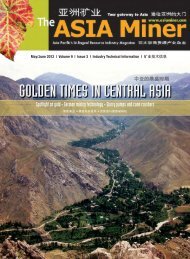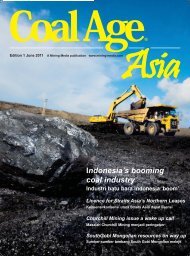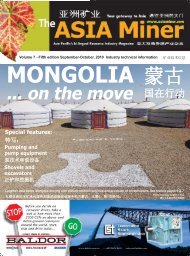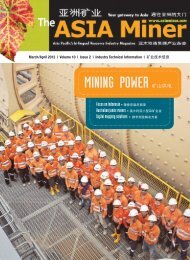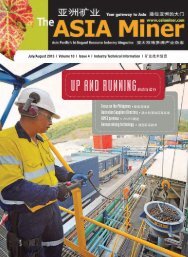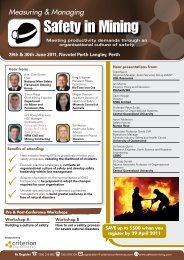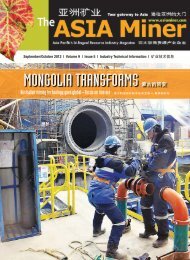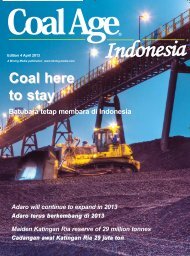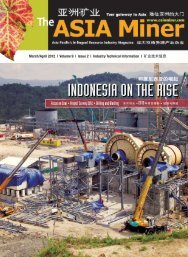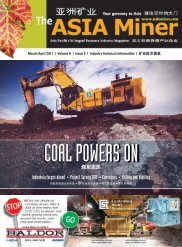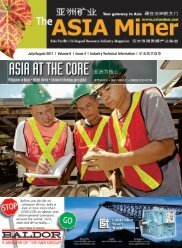May/June 2013 - The ASIA Miner
May/June 2013 - The ASIA Miner
May/June 2013 - The ASIA Miner
You also want an ePaper? Increase the reach of your titles
YUMPU automatically turns print PDFs into web optimized ePapers that Google loves.
Mining Success Stories<br />
New life for<br />
HISTORIC BALLARAT GOLD OPERATION<br />
By John Miller, editor <strong>The</strong> <strong>ASIA</strong> <strong>Miner</strong><br />
LionGold’s Ballarat Gold Mine is surrounded by residential and commercial properties in Ballarat’s southern suburbs.<br />
SINGAPORE-listed LionGold Corporation has<br />
helped a junior Australian company turn<br />
around the fortunes of the historic Ballarat Gold<br />
Mine, continuing a heritage of mining in the<br />
Australian city which stretches back more than<br />
150 years. Since completing a takeover of<br />
Castlemaine Goldfields in 2012 and backing<br />
up the mining expertise of that company with<br />
its financial strength and business acumen, LionGold<br />
has become a gold producer and aims<br />
to make its mark on the world gold stage.<br />
<strong>The</strong> mine is only a small producer compared<br />
to the world’s major mines but difficult<br />
geology and location under a settlement of<br />
100,000 people make it a modern day success<br />
story and one that has put the Victorian<br />
Goldfields’ city back into the spotlight. <strong>The</strong><br />
operations and processing facilities are ringed<br />
by Ballarat’s southern suburbs, the decline<br />
extends 3.5km to the north under the city,<br />
and the area being mined is about 4 blocks<br />
from the city centre and about 600 metres<br />
under the ground.<br />
LionGold’s group chief operating officer<br />
Matthew Gill, who is also managing director<br />
of Castlemaine Goldfields, says the company<br />
is intimately associated with the city which<br />
means noise, dust, vehicle access and vibration<br />
are key environmental considerations.<br />
“Another important factor is water management<br />
with ground water discharge from the<br />
underground mine treated and discharged<br />
under our strict environmental discharge licence.<br />
In line with other environmental licence<br />
obligations, the cyanide solution used<br />
in the processing of gold ore is treated (destroyed<br />
chemically) and the resultant solution<br />
contained on site within a purpose-built fully<br />
lined and self-contained tailings dam alongside<br />
the Yarrowee River.”<br />
He says, “Community interaction is fundamental<br />
and there is a consultative committee<br />
that meets quarterly and is chaired independently.<br />
It is important in all mining operations<br />
but even more so here because of our<br />
location. We recognize that it is important to<br />
be proactive and some of our activities have<br />
included a community survey, the publication<br />
of a regular community newsletter, mine open<br />
days, visits to local schools and we sponsor<br />
a primary school teacher in the local area.”<br />
<strong>The</strong> 1850s gold rush provided the kickstart<br />
for mining in the region and there are<br />
deep mining roots which mean most people<br />
are interested in it and acknowledge its<br />
importance. <strong>The</strong>re is also the Sovereign Hill<br />
gold mining tourist village next door to the<br />
mine, the adjacent gold museum and Eureka<br />
Stockade precinct marking the 1854<br />
rebellion by gold miners, which add to the<br />
mining heritage.<br />
“We directly employ 150 people who all live<br />
in the area while the gearing of indirect employment<br />
is about three-to-one, meaning<br />
some 450 people benefit from our business,”<br />
he says. “Our payroll is about $1 million a<br />
month and then there are the goods and<br />
services purchased locally. <strong>The</strong> employment<br />
and mining heritage give us a degree of understanding<br />
and support by the community<br />
that many other communities don’t have, but<br />
we can’t take it for granted and have to keep<br />
working at it. <strong>The</strong>re are people in Ballarat who<br />
don’t know we are here so our commitment<br />
to consultation is vital. Our operations and<br />
historic workings are screened by trees and<br />
vegetation, including pine plantations, and together<br />
with extensive, ongoing engagement,<br />
we believe the community has given us a licence<br />
to operate.”<br />
Gold processing results in 75% of the gold<br />
being recovered using gravity processes<br />
(gold is exceptionally heavy) with another<br />
10% achieved through dissolving gold using<br />
a cyanide solution. With the waste and<br />
detoxified water then going into the tailings<br />
dam, water recovery is important. No water<br />
from the tailings dam is discharged to the environment.<br />
Castlemaine does extensive underground<br />
mine water discharge monitoring.<br />
Noise and dust are constantly monitored with<br />
the nearest house only 200 metres away.<br />
<strong>The</strong>re is also a curfew on bringing goods and<br />
materials onto the site with no deliveries at<br />
night or on weekends.<br />
Castlemaine Goldfields the company listed<br />
on the Australian Stock Exchange in 2005<br />
with three tenement packages in the Central<br />
Victorian Goldfields – Castlemaine which was<br />
the third largest gold producer in Victoria behind<br />
Ballarat and Bendigo, and features<br />
prominently in gold rush stories; Sebastian,<br />
immediately north of Bendigo and site of the<br />
Frederick <strong>The</strong> Great mine; and Tarnagulla,<br />
well known for nuggets including the 71kg<br />
Welcome Stranger found in 1869 and which<br />
is the world’s largest alluvial gold nugget. <strong>The</strong><br />
Castlemaine tenement includes Wattle Gully<br />
mine which was mined from the 1930s to the<br />
1990s, producing over 400,000 ounces.<br />
About 200 metres east of that mine the company<br />
discovered a parallel zone called the<br />
Chewton Deposit and in 2008 a JORC inferred<br />
resource of more than 600,000 ounces<br />
was announced. <strong>The</strong> company is now drilling<br />
to infill this resource.<br />
4 | <strong>ASIA</strong> <strong>Miner</strong> | <strong>May</strong>/<strong>June</strong> <strong>2013</strong>



